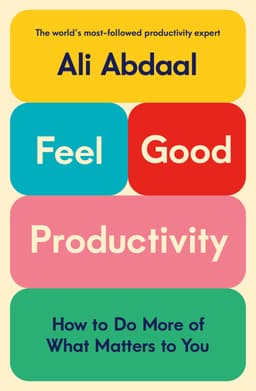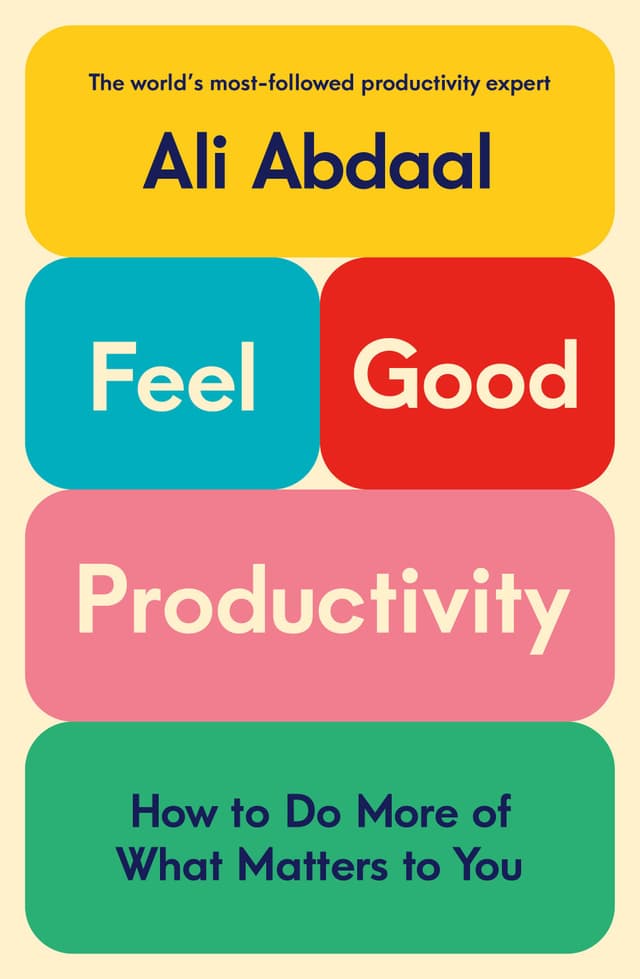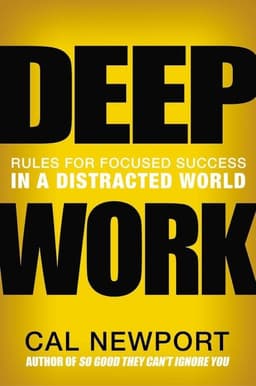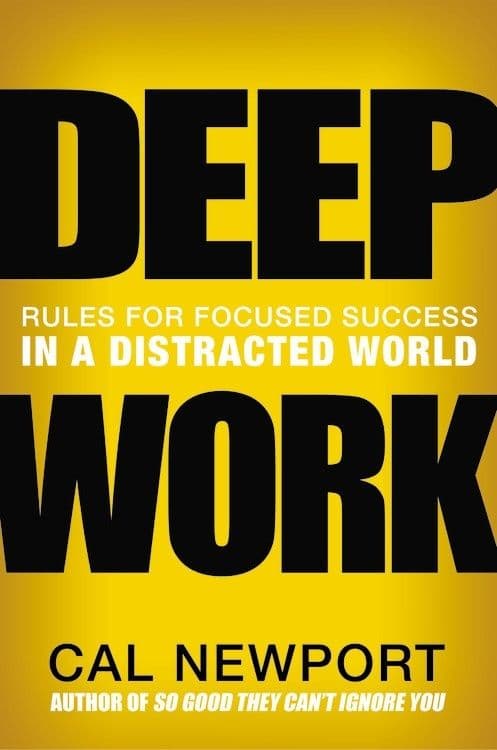
Slow Productivity Book Summary
The Lost Art of Accomplishment Without Burnout
Book by Cal Newport
Feeling Lazy?Read 1 Minute Summary
Summary
In "Slow Productivity," Cal Newport argues that the key to producing meaningful knowledge work is rejecting busyness and distraction in favor of a more deliberate approach that prioritizes quality, focus, and a sustainable pace.
Sign in to rate
Average Rating: 5
Part 1: Foundations
John McPhee's Creative Process Embodies Slow Productivity
The book opens with the story of writer John McPhee, who in 1966 spent two weeks lying on a picnic table in his backyard, staring up at an ash tree, trying to figure out how to structure a complicated article he was struggling to write. This languid, unhurried approach to his creative process exemplifies the core principles of slow productivity that the book will explore. McPhee's career demonstrates that meaningful accomplishment does not require constant busyness and frantic intensity.
Section: 1, Chapter: 1
Slow Productivity Definition
The book presents slow productivity as an alternative philosophy for organizing knowledge work in a more sustainable and meaningful way. Its three core principles are:
- Do fewer things
- Work at a natural pace
- Obsess over quality
By following these principles, the book argues, knowledge workers can escape the epidemic of overload and produce work they're proud of without grinding themselves down in the process.
Section: 1, Chapter: 1
Slow Productivity Rejects Busyness
Slow productivity rejects busyness, seeing overload as an obstacle to producing results that matter, not a badge of pride.
Section: 1, Chapter: 1
Productivity Is Hard To Define In Knowledge Work
Productivity is a well-defined concept in sectors like agriculture and manufacturing, where outputs and processes are concrete. But in knowledge work, which emerged as a major economic force in the mid-20th century, the nature of productivity is much more ambiguous.
Managers didn't know how to measure or improve productivity for these more cognitively-complex jobs. In response, they defaulted to using visible activity, like hours spent in the office or messages sent, as a proxy for productivity. The more activity you see, the more you assume an employee is contributing.
Section: 1, Chapter: 1
Technology Supercharged Pseudo-Productivity
The rise of digital communication tools like email and instant messaging in the 1990s and 2000s turned the proxy of visible activity into an arms race of electronic busyness. Knowledge workers could now signal their "productivity" by sending messages at all hours, leading to an onslaught of low-value communication that left everyone feeling overwhelmed but still under pressure to keep up the charade of looking busy.
This state of affairs, which Newport terms "pseudo-productivity," is neither sustainable nor conducive to getting the right things done. But it remains the dominant way work is organized and evaluated in many organizations.
Section: 1, Chapter: 1
The Rise of Psuedo-Productivity
In the absence of more sophisticated measures of effectiveness, we also gravitate away from deeper efforts toward shallower, more concrete tasks that can be more easily checked off a to-do list.
Section: 1, Chapter: 1
Slow Productivity Focuses On Meaningful Accomplishment
Here's a key tenet of slow productivity - what matters is the ultimate result, not the appearance of staying busy. As you evaluate your own work habits, consider where you may be conflating the two. Are you spending time on things that look or feel productive but don't meaningfully advance your most important projects? See if you can shift more of your time and attention to the efforts that make the biggest difference, even if they unfold at a slower pace. Don't use busyness as a proxy for effectiveness.
Section: 1, Chapter: 1
The Slow Food Movement Was A Reaction Against Fast Living
In 1986, Carlo Petrini launched the Slow Food movement in Italy as a response to the arrival of McDonald's and American fast food culture. Rather than just complaining, Slow Food presented an appealing alternative - a return to traditional, communal meals made with local ingredients and eaten at a leisurely pace.
The movement celebrated the pleasure of slow, intentional dining as an antidote to the alienation of modern speed and homogenization. This exemplifies two key strategies for creating cultural change - offer an attractive alternative and leverage time-tested wisdom.
Section: 1, Chapter: 2
The Slow Movement Expanded Beyond Food
Following the success of Slow Food, a variety of other slow movements emerged to advocate for more intentional, human-friendly approaches to travel, parenting, education, reading and more.
While the specific practices differ, they share a common sensibility - that doing things at a more natural pace, often informed by cultural tradition, yields a richer experience than defaulting to the hectic norms of modernity. These movements demonstrate that the core ideas behind Slow Food can be translated to many different domains.
Section: 1, Chapter: 2
Hunter-Gatherer Societies Show The Naturalness Of Fluctuating Work Intensity
Anthropological studies of the few remaining hunter-gatherer societies show that their "work" of acquiring food unfolds at a fluctuating pace. Periods of intense effort, like a long hunting trip, are typically followed by stretches of rest and socializing. This contrasts with the artificially constant intensity demanded by industrial and knowledge work.
The studies suggest that our evolutionary heritage is better adapted to a work rhythm that ebbs and flows rather than maintaining an unsustainably high static level. Slow productivity aims to restore this more natural cadence to our efforts.
Section: 1, Chapter: 2
Slow Productivity Doesn't Mean Low Productivity
A common misconception is that working slower means getting less done. But as the hunter-gatherer example shows, a fluctuating pace doesn't necessarily lower overall output. In fact, the intense bursts enable higher quality efforts that can produce outsized results, making up for any "lost" time spent resting or recharging.
As you experiment with slow productivity, embrace this underlying truth. Judge your success not by how constantly busy you are, but by the ultimate results you're able to generate by working at a more natural rhythm. You may be surprised by how much you're still able to achieve.
Section: 1, Chapter: 2
Part 2: Principles
Jane Austen Produced More When Her Obligations Were Reduced
Popular lore holds that Jane Austen wrote her novels in the snatches of time between endless social engagements. But a closer look at her life reveals a different story.
Austen was most productive as a writer during an extended period when she was largely freed from both domestic chores and social commitments. Living at Chawton Cottage with her sister, mother and a friend, she was able to spend her days focused primarily on writing, without many external obligations to sap her time and attention. This unencumbered lifestyle enabled her to write her most celebrated works.
Section: 2, Chapter: 3
The Overhead Tax Of More Projects
Every project you take on incurs an "overhead tax" - the time required for logistical tasks like meetings, email, and context switching that don't directly advance the project itself.
As you take on more simultaneous projects, this overhead balloons and eventually hits a tipping point where you spend the majority of your time just managing the administrative detritus generated by your overflowing slate of responsibilities.
This leaves little time for real productive work and induces an overwhelming sense of busyness. Cutting back on the number of projects you take on at once contains this overhead tax and frees up time for more substantive progress.
Section: 2, Chapter: 3
Focus Enables Higher Quality Work
In addition to increasing the time available for real work, taking on fewer obligations at once also improves the quality of the work you do. With your attention less fractured, you're able to approach each task with greater focus, creativity and care.
You can dig deeper on hard problems and come up with more innovative solutions instead of just trying to hastily check things off a too-long to-do list. The resulting work is more thoughtful and impactful. Doing less allows you to do better.
Section: 2, Chapter: 3
Self-Regulation Keeps Knowledge Workers On The Edge Of Overload
For knowledge workers who have some autonomy over their workload, overcommitment often stems from a flawed strategy of self-regulation. We say yes to new requests until we feel so stressed and overwhelmed that we believe we have an unimpeachable excuse for saying no. This guarantees we'll be permanently teetering on the edge of being overscheduled.
A more sustainable approach is to proactively contain your commitments well before you hit a breaking point. Establish clear policies for what you will and won't take on, communicate these boundaries and defend your limited capacity so that you never end up with more on your plate than you can handle.
Section: 2, Chapter: 3
Limit The Big Things And Contain The Small Things
Newport provides two key strategies for reducing your obligations in a professional context:
- Limit the big things. Be intentional about taking on fewer major projects and responsibilities. Set policies for how many you'll allow at once.
- Contain the small things. Use tactics like office hours, templates, and process checklists to streamline, delegate or defer the administrative minutiae that can overwhelm your schedule if left unchecked.
Section: 2, Chapter: 3
Great Scientists Advanced Slowly and Steadily
When you examine the lives of great scientists like Isaac Newton and the Curies, you find that their groundbreaking discoveries didn't emerge from constant nose-to-the-grindstone effort. There were sprints of intense work, but also long stretches where progress unfolded much more gradually - a season pondering under the apple trees at Woolsthorpe Manor, an interlude hiking the French countryside.
The scientists didn't try to maintain a constant breakneck pace. They took detours to recharge, made slow and steady advances, and periodically accelerated when needed. Genius-level breakthroughs emerged from a working rhythm that looks positively leisurely by modern standards.
Section: 2, Chapter: 4
"Humans Aren't Wired For Constant, Unvarying Effort"
"Humans Aren't Wired For Constant, Unvarying Effort"
The natural work style of great scientists mirrors anthropological findings about the "original" productivity of hunter-gatherers. Unencumbered by the artificial discipline of industrial capitalism, hunter-gatherers work in an oscillating rhythm of intense effort offset by extensive rest and socializing. This is likely the pattern of exertion that human beings evolved to sustain. In contrast, the relentless, unvarying intensity demanded by industrial and knowledge work schedules is deeply unnatural. It requires fighting against our innate need for fluctuating energy expenditure.
Section: 2, Chapter: 4
Slow Productivity Means Embracing Ebbs and Flows
A core tenet of slow productivity is rejecting the need to maintain a constantly high level of intensity. Instead, embrace a working rhythm that allows for natural ebbs and flows:
- Schedule "slow seasons" where you intentionally reduce your workload and external obligations in order to recharge
- Build reflective downtime into your days and weeks
- Protect time for deep focus on your most important projects
- Allow bursts of intensity when needed, but avoid making them your default
Section: 2, Chapter: 4
Take Longer Developing Important Projects
One way to work at a more natural pace is to take more time shepherding your most important projects from conception to completion. Newport suggests several strategies for embracing this "slow hunch" approach:
- Maintain a 5-year vision for the big things you want to accomplish
- Double your estimated project timelines to give yourself adequate breathing room
- Simplify your daily schedule so you have time to make steady, incremental progress
- Return to projects repeatedly over time as you develop new ideas and insights
Section: 2, Chapter: 4
Match Your Tools And Spaces To The Desired Mood Of The Work
Another component of working at a natural pace is selecting physical environments and rituals that produce a state of mind conducive to the work you're trying to do. For intellectually demanding tasks, Newport suggests:
- Choosing spaces that minimize distractions and promote focus, like private offices or libraries
- Using high-quality tools, whether notebooks or software programs, that you enjoy interfacing with
- Developing rituals, like a pre-writing walk or an afternoon tea, that act as a mental on-ramp for challenging work
Section: 2, Chapter: 4
Jewel Took A Slow Approach To Avoid Compromising Her Music
When singer-songwriter Jewel got a major label record deal, she made the unorthodox choice to turn down a million-dollar signing bonus. Her concern was that taking such a big advance would put pressure on her to rush out music that was more commercially-oriented rather than true to her artistic vision.
By minimizing her upfront payouts, Jewel freed herself to take a slower, more craftsman-like approach to developing her debut album. She focused on honing her live show and building a grassroots following rather than scoring a quick radio hit. This patience paid off when her music eventually found a wide audience on its own terms.
Section: 2, Chapter: 5
Focusing On Process Over Immediate Rewards Enables Better Work
Jewel's decision reflects a core principle of slow productivity - that to do your best work, you have to be willing to prioritize process over immediate payoffs. It's tempting to take the short-term money or recognition, but these incentives often come with strings attached that impede true quality.
By taking a longer view and having the discipline to invest in your craft without expectation of immediate rewards, you give yourself the space needed to reach your full potential. You can work more methodically and thoughtfully, taking however much time is needed to get the details right.
Section: 2, Chapter: 5
Mastery Requires Putting In The Reps
Obsessing over quality doesn't mean demanding perfection on your first attempt. In fact, producing great work often requires iterating repeatedly and being willing to put in the reps to master your craft. Some strategies for embracing this apprenticeship mindset:
- Study the work of experts in your field to absorb best practices and expand your sense of what's possible
- Put in the hours of deliberate practice required to hone your skills, even if progress feels slow
- Actively seek out feedback from trusted peers and mentors and use it to guide your efforts
- Judge your work by how much you're learning and improving, not just the current quality of your output
Section: 2, Chapter: 5
Obsess Over Quality
We've become so used to the idea that the only reward for getting better is moving toward higher income and increased responsibilities that we forget that the fruits of pursuing quality can also be harvested in the form of a more sustainable lifestyle.
Section: 2, Chapter: 5
Quality Enables Autonomy
An obsession with quality isn't just about the nobility of doing good work. It's also a savvy business strategy. When your output is in high demand because of its excellence, you gain leverage to dictate the terms of your working life. Clients seek you out and are willing to pay a premium. Collaborators value your contributions and defer to your judgment.
With an exceptional track record, you can be more selective about what you take on and design a schedule that suits you. In this way, quality and autonomy become mutually reinforcing - doing excellent work earns you the freedom to keep doing excellent work on your own terms.
Section: 2, Chapter: 5
Related Content


Feel Good Productivity Book Summary
Ali Abdaal
"Feel-Good Productivity" by Ali Abdaal is a transformative guide that teaches us how to harness the power of positive emotions, overcome mental roadblocks, and achieve sustainable success by aligning our actions with our values.
"Feel-Good Productivity" by Ali Abdaal is a transformative guide that teaches us how to harness the power of positive emotions, overcome mental roadblocks, and achieve sustainable success by aligning our actions with our values.
Personal Development
Productivity
Goal Setting
Habits
Happiness


Deep Work Book Summary
Cal Newport
In "Deep Work", Cal Newport argues that the ability to focus intensely on cognitively demanding tasks is becoming increasingly rare yet increasingly valuable in our economy, and provides a training regimen to cultivate this skill through the application of four rules: work deeply, embrace boredom, quit social media, and drain the shallows.
In "Deep Work", Cal Newport argues that the ability to focus intensely on cognitively demanding tasks is becoming increasingly rare yet increasingly valuable in our economy, and provides a training regimen to cultivate this skill through the application of four rules: work deeply, embrace boredom, quit social media, and drain the shallows.
Productivity
Personal Development
Time Management

